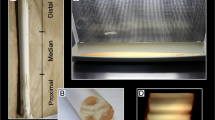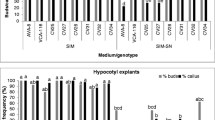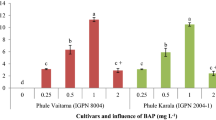Abstract
Axillary buds (2 mm) from 3-year-old Carica pubescens Lenné et Koch (highland papaya) fruit-bearing plants grown in the greenhouse were cultivated in NN-medium supplemented with different growth regulators naphthaleneacetic acid and indoleacetic acid in combination with Zeatin, benzyladenine, Kinetin and thidiazuron. Several responses were observed within 2–3 months; namely, sprouting of the preformed axillary buds, bud branching into multiple shoots, callus formation at the basal end of the explant and somatic embryogenesis in the preformed callus. Somatic embryogenesis was frequent in most of the tested growth regulator combinations, with the exception of thidiazuron which showed no effect. A much higher yield of somatic embryos could be obtained in suspensions. Somatic embryogenesis was enhanced by the occurence of adventive embryogenesis on single embryos as globular embryo clusters. This was observed in cell suspensions initially grown in a WPM-medium with 2,4-dichlorophenoxyacetic acid, or in combination with benzyladenine or zeatin, for 6 days, then maintained in a growth regulator-free medium under continuous agitation (50 RPM) on an orbital shaker for 3 months. Single cells grown in the absence of 2,4-dichlorophenoxyacetic acid did not initiate embryogenesis and de-differentiated into callus. Plantlets were recovered after transfer of mature embryos from cell suspensions into Magenta flasks. In a second subculture, adventitious embryogenesis occurred spontaneously in clusters at the globular embryo stage under the same growth conditions, yielding a high number of embryos. The culture conditions described above allowed initiation of a large number of somatic embryos directly from cell suspensions through adventive somatic embryogenesis and indirectly from callus on axillary buds.
Similar content being viewed by others
Abbreviations
- 2,4-d :
-
dichlorophenoxyacetic acid
- CH:
-
casein enzymatic hydrolysate
- BA:
-
benzyladenine
- FAA:
-
formalin:acetic acid:alcohol
- Glu:
-
l-glutamine
- IAA:
-
indoleacetic acid
- NAA:
-
naphthaleneacetic acid
- NN:
-
Nitsch and Nitsch-medium (1969)
- TDZ:
-
thidiazuron
- SD:
-
standard deviation
References
Cardenas M (1989) Manual de Plantas Económicas de Bolivia. Ed. Los Amigos del Libro, La Paz (333 p.)
Drew R A & Smith N G (1986) Growth of apical and lateral buds of papaw (Carica papaya L.) as affected by nutritional and hormonal factors. J. Hort. Sci. 61:535–543
Drew R A (1988) Rapid clonal propagation of papaya in vitro from mature field-grown trees. HortScience 23:609–611
Durzan D J (1988) Process control in somatic polyembryogenesis. In: Hällgren J E (ed) Proc. of the Frans Kempe Symp. Molecular Genetics of Forest Trees. June 14–16 Umek Sweden. Report N0 8:147–186
Jordan M (1986) Somatic embryogenesis from cell suspension culture in Carica candamarcensis. Plant Cell Tiss. Org. Cult. 7: 257–261
Jordan M (1989) Cell and tissue culture potentialities to regenerate three papaya species (Carica candamarcensis, C. papaya and C. pentagona.) Erwerbobstbau 31:90–94
Jordan M (1990) Regeneración in vitro y aplicaciones a través del cultivo de células y tejidos vegetales. Arch. Biol. Med. Exp. 23:113–117
Jordan M (1992) Micropropagation of Papaya (Carica sp). In: Bajaj Y P S (ed) Biotechnology in Agriculture and Forestry, Vol 18 (pp 418–459) Springer-Verlag
Jordan M, Cortés I & Montenegro G (1983) Regeneration of plantlets by embryogenesis from callus cultures of Carica candamarcensis. Plant. Sci. Lett. 28:321–326
Jordan M, Ciudad G, Rojas M L & Valverde F (1986) Isolation, culture and fusion of Carica candamarcensis and C. papaya protoplasts. Gartenbauwissenschaft 51:175–178
Kreuger M & Gerrit-Janvan Holst (1993) Arabinogalactan proteins are essential in somatic embryogenesis of Daucus carota L. Planta 189:243–248
Litz R & Conover R A (1978) In vitro propagation of papaya. HortSci. 13:241–242
Litz R & Conover R A (1980) Somatic embryogenesis in cell cultures of Carica stipulata. HortSci. 15:733–735
Litz R & Conover R A (1981) Effect of sex type, season, and other factors of in vitro establishment and culture of Carica papaya explants. Amer. Soc. Hort. Sci. 106:792–794
Lloyd G & McCown BH (1981) Woody Plant Medium — A mineral nutrient formulation for microculture of woody plant species. HortSci. 16:453
Mondal M F (1992) Sex identification of papaya at the seedling stage. Bangladesh J. of Botany 21:303
National Research Council (1989) Lost crops of the Incas: Little-Known Plants of the Andes with Promise for Worldwide Cultivation. National Academy Press, Washington, D.C
Nitsch J P & Nitsch C (1969) Haploid plants from pollen grains. Science 163:85–87
Rajeevan M S & Pandey R M (1986) Lateral bud culture of papaya (Carica papaya L.) for clonal propagation. Plant Cell Tiss. Org. Cult. 6:181–188
Author information
Authors and Affiliations
Rights and permissions
About this article
Cite this article
Jordan, M., Velozo, J. Improvement of somatic embryogenesis in highland-papaya cell suspensions. Plant Cell Tiss Organ Cult 44, 189–194 (1996). https://doi.org/10.1007/BF00048523
Received:
Accepted:
Issue Date:
DOI: https://doi.org/10.1007/BF00048523




